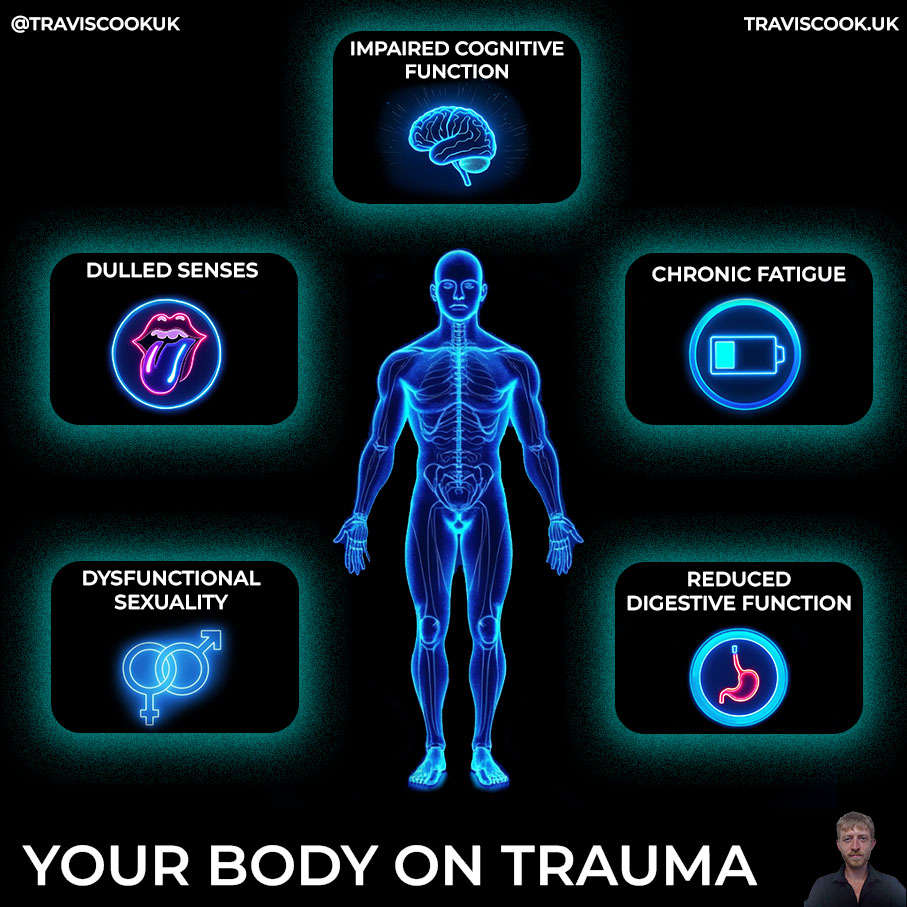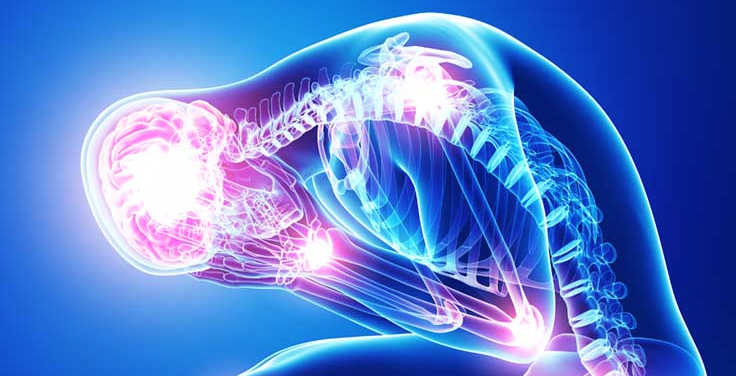How To Clear Trauma With Body Mind Practices
I don’t know about you but I’ve heard a lot about trauma in all its different variations but when it comes to actually doing something about this trauma the information provided is always vague and not clear. In this article I will clearly define trauma, how and why we accumulate trauma, the biology and psychology behind trauma, and then I will breakdown the practical steps to take and modalities to utilise to clear trauma for good.
Clearing trauma is an integral part of shadow work. We all accumulate trauma throughout life, its just the way of the world at the moment. There can be either big traumatic events or lots of little mini traumatic events building up over time. The body stores trauma in different areas. If too much trauma is built up over time this will lead to a physical disease. Trauma can kill you if it is too much not dealt with for too long. IT would be interesting if we could see just how many different diseases people are dealing with are due to unprocessed trauma.
Unhealed wounds and unprocessed trauma from years ago can unconsciously impact how we think, feel and act in our daily lives today. Clearing trauma is not only the key to dramatically increasing our energy levels, peace of mind, overall health, quality of sleep, interactions and relationships with people, our self perception and so much more, it is also how we are clear the vessel and allow for more divine light to enter our being. To embody our soul, raising our own personal vibe and doing massive damage against the agenda of evil on the metaphysical realms.
Evil needs as many people as possible in a low vibration to be able to keep humanity locked down in a frequency prison. When we clear our trauma, become more embodied, positively program our minds, and bring more light into ourselves we are effectively fighting back in the spiritual war.

What Is Trauma?
Trauma refers to an emotional response to a distressing event or series of events that either overwhelms our ability to cope causing feelings of helplessness, diminishing our sense of self and our ability to feel a full range of emotions or consistently denies us the necessary building blocks needed to form a health complete being.
We all have our own shit to deal with to varying degrees. Not much point in comparing who has been through more because that’s a lose lose situation. Rather, we should accept we have been through trauma in one way or another and then begin to do the work needed to clear the trauma.
Big ‘T’ Traumas are singular, catastrophic events like natural disasters, violent attacks, or severe accidents. These are events that are widely recognised as traumatic and often lead to conditions like Post Traumatic Stress Disorder (PTSD).
Little ‘t’ Traumas, on the other hand, are less obvious but can be equally damaging over time. These include ongoing issues like emotional neglect, microaggressions, or living in a subtly dysfunctional environment. They accumulate, affecting mental health subtly but profoundly, often leading to complex trauma. Unfortunately due to the sum total of the collective not dealing with their shit, this kind of trauma is at epidemic levels in our society.
“After trauma the world is experienced with a different nervous system that has an altered perception of risk and safety. Porges coined the word “neuroception” to describe the capacity to evaluate relative danger and safety in one’s environment. When we try to help people with faulty neuroception, the great challenge is finding ways to reset their physiology, so that their survival mechanisms stop working against them. This means helping them to respond appropriately to danger but, even more, to recover the capacity to experience safety, relaxation, and true reciprocity.”
How Can I Recognise Trauma In Myself And Others?

Even though we all have trauma to varying degress, some of us have been through more and will be carrying more of a burden. Another factor is some people are better at internalising their trauma as compared with dumping it all on others. Recognising trauma involves understanding both the overt and subtle signs that indicate someone might be suffering from its effects.
Trauma can manifest through various symptoms
Emotional Responses
These include intense anxiety, panic attacks, feelings of sadness, hopelessness, or being emotionally numb. People might also suffer from irritability, mood swings, or a sense of being disconnected from their surroundings or themselves.
Physical Symptoms
Trauma often has physical manifestations like headaches, fatigue, racing heartbeat, or unexplained aches and pains. These symptoms reflect the body’s response to prolonged stress.
Behavioural Changes
This can involve avoidance of places, people, or activities that remind one of the traumatic event, social withdrawal, or engaging in self-destructive behaviours like substance abuse.
Cognitive Effects
Difficulty concentrating, memory issues, or persistent intrusive thoughts about the event are common. There might also be a sense of disorientation or confusion.
Relational Impact
Trauma can lead to difficulties in relationships, such as increased conflict, a lack of trust, or feeling detached from loved ones.
Psychological Patterns
This includes phenomena like dissociation, where an individual feels detached from their own body or reality, or trauma repetition, where one might unconsciously recreate traumatic scenarios.

How Is Trauma Stored In The Body?
Trauma significantly impacts both the mind and body. It could be said that installing trauma into the population is one of the greatest tactics deployed by evil to try and control humanity. Traumatised people who don’t believe in themselves and their own self worth and power are far easier to control. Scientifically, trauma is understood to be stored not just in our conscious memory but deeply within our unconscious mind, and bodily tissues.
The Brain’s Role
The amygdala, a key player in emotional processing, becomes hyperactive in response to trauma, storing emotional memories linked to fear. This can lead to PTSD, where the mere reminder of the trauma triggers a fight-or-flight response due to an enlarged or hyperactive amygdala.
Unconscious Encoding
Traumatic memories can be encoded in an altered state of consciousness, primarily through the activation of extra-synaptic GABA receptors, as opposed to the glutamate system used for normal memory encoding. This means these memories are not easily accessible consciously but can influence behaviour and physical states unconsciously.
The Body Keeps the Score
Bessel van der Kolk’s research highlights that trauma also manifests physically. Muscles and connective tissues can hold tension from chronic stress, leading to physical symptoms like headaches or back pain. This phenomenon is often referred to as “body memories,” where the body remembers trauma as somatic sensations.
Neuroplasticity and Repetition
Trauma responses can become wired into the brain’s neural pathways, especially if the trauma occurs during brain development stages. This can lead to automatic responses like freezing when faced with new stressors, illustrating how trauma shapes both the unconscious mind and bodily reactions.
The Parasympathetic and Sympathetic nervous systems
The Parasympathetic Nervous System (PNS) and Sympathetic Nervous System (SNS) control involuntary body functions. The SNS, or “fight or flight,” responds to stress by increasing heart rate and preparing for action. As stress or trauma resolves, SNS activity reduces, promoting relaxation. Conversely, the PNS, or “rest and digest,” slows heart rate and aids recovery, becoming more active as trauma clears, enhancing calm and healing.
Because of trauma a lot of people are in a constant state of fight or flight to deal with a danger that isn’t there anymore. This has all sorts of negative impacts on the body and can eventually cause disease. The SNS takes over and the PNS is shut down. Whilst in a state of constant SNS activation its common to experience symptoms like chronic pain, tension or fatigue, trouble relaxing, addictive tendencies, poor sex life, dulling of the senses, low quality sleep and more. The whole body is affected by trauma.
This integration of trauma into the body’s biology explains why emotional and physical health are deeply intertwined, affecting how individuals react to future stressors unconsciously. Wanna sort our your triggers? Get clearing that trauma! How can we activate the PNS and begin the journey of clearing our trauma? Body/mind practices!

What Does Clearing Trauma Feel Like?
Clearing trapped trauma, energy and emotion can result in a variety of bodily reactions. During a trauma clearing session, you might feel an emotional release, like a weight lifting off your chest. Physically, there’s often a sensation of lightness or tingling as tension dissolves. Your breath might deepen, signaling your parasympathetic nervous system kicking in, promoting relaxation. You may experience waves of chills or warmth, reflecting energy flow changes. Emotionally, there could be moments of sadness, relief, or even joy as stuck energies are processed. It’s not uncommon to experience vivid memories or insights, as your mind-body connection re-aligns, fostering a sense of peace or grounding, showing your body’s return to homeostasis.
For example, I can remember once when I was really deep into a meditation once, I managed to unlock and unblock something. At first I having weird dark images flash in my mind, then minor convulsions and body movements. Then this session peaked with me arching my back and going to scream and no noise coming out but my body tensing up and then releasing completely. After this session I felt amazing!

What Are The Benefits Of Clearing Trauma?
Clearing trauma has profound implications not just for personal well-being but for humanity as a whole. When we heal from trauma, we reduce the automatic, mechanical reactions often rooted in fear, anger, or defence mechanisms. These reactions, if unchecked, contribute to the collective shadow—the sum of all unconscious, often negative, behaviours and emotions within a society. People working on themselves is ultimately how we win.
By Addressing and Healing Trauma You Will Enjoy
Reduced Reactivity
Individuals become less likely to perpetuate cycles of aggression or misunderstanding, thereby decreasing collective tension and conflict.
Conscious Interaction
Healed individuals engage with the world more consciously, promoting empathy and understanding, which counters the spread of the collective shadow.
Energy Reclamation
Trauma healing frees up mental and emotional energy, allowing for positive contributions to society rather than projecting unresolved issues outward.
Lead By Example
As more people engage in trauma healing, it sets a societal precedent, encouraging a culture of healing over suppression, thereby shifting the collective consciousness towards healing and away from perpetuating shadow elements.
This process helps in breaking the cycle of trauma transmission across generations and within communities, fostering a more harmonious collective existence where individuals contribute to, rather than detract from, the social fabric through mindful presence rather than mechanical reaction.

Trauma Clearing Modalities
Yoga
Yoga is a very powerful tool for embodiment and clearing trauma. With its focus on deep breathing, mindfulness and stretching and relaxing the body. This helps to activate the PNS and will improve how traumatised people will deal with life and their reactions. When the body is relaxed enough for long enough it allows the brain to process and release stored traumatic memories, which are often held in the body as tension or pain.
Yoga also encourages mindfulness, grounding individuals in the present moment, which can mitigate dissociative symptoms by preventing the mind from drifting into traumatic memories. Getting a good control over and understanding of our mind can help when we need to keep the mind in check and not execssively wallowing in negativity.
Controlled breathing activates the vagus nerve, which helps reduce heart rate and blood pressure, promoting a state of calm. This activation of the parasympathetic nervous system down-regulates the body’s fight-or-flight response, which is often hyperactive in individuals with trauma. By stabilizing the breath, pranayama also helps regulate the release of neurotransmitters such as GABA (gamma-aminobutyric acid), which has a calming effect on the brain.
breathwork
Breathwork directly influences the Autonomic Nervous System, Through deep, slow breathing. Breathwork activates the (PNS), particularly the vagus nerve. This activation promotes a state of relaxation, reducing heart rate, blood pressure, and cortisol levels, and shifting the body away from the stress response toward rest and healing.
Controlled breathing affects the balance of neurotransmitters in the brain. Techniques like diaphragmatic breathing increase the release of GABA (gamma-aminobutyric acid), which inhibits neuronal excitability and produces a calming effect. Additionally, Breathwork can enhance the release of endorphins and serotonin, which elevate mood and counteract the depressive symptoms often associated with trauma. Breathwork optimises oxygen delivery to tissues and maintains proper pH balance in the blood. Hyperventilation, often experienced in panic attacks or anxiety, reduces CO2 levels and causes respiratory alkalosis, leading to dizziness and heightened anxiety. Controlled Breathwork restores balance by regulating CO2 and oxygen levels, which stabilises physiological functions and prevents the onset of panic symptoms.
What is quite common, especially in Breathwork journey’s lead by an experienced practitioner is that people will during and after the practice have emotional releases as their bodies feel safe enough to process trapped emotions. What is very interesting is how doing Breathwork within a group container can amplify this effect. Group Breathwork enhances trauma release by creating a shared sense of safety and acceptance – The Acceptance Effect. When we engage in Breathwork together, the collective energy and shared experiences create a supportive environment. This communal space allows participants to feel understood and validated, making it easier to process and release trauma.
Qi Gong
Practicing Qi Gong can be like giving your body a gentle, energising hug. This ancient technique boosts your energy levels, or Qi, helping to heal trauma by enhancing the flow of energy through your body, including the fascia – that’s the connective tissue wrapping around your muscles and organs. Think of it as a network that, when blocked, can stiffen up, much like how we feel when stressed. Qi Gong’s slow, mindful movements and deep breathing work to unblock and smooth out these energy pathways, promoting a sense of peace and physical release. Over time, this can help dissolve the physical hold of trauma, making you feel more vibrant and connected, inside and out.
This clearing of trauma via increasing the energy flow throughout the body could be how tens of thousands of people were and are being healed of various ‘incurable’ ailments with the powerful branch of healing Qi Gong known as Zhi Neng Qi Gong.
Meditation
Meditation can be a game-changer for healing trauma, and here’s why: it actually helps to rewire your brain. When you meditate, especially with focused meditation techniques like body scanning, you’re giving your brain a workout, especially areas like the prefrontal cortex, which helps with emotional regulation. Studies suggest that regular meditation can shrink the amygdala, that part of your brain that goes into overdrive with fear and stress. This means less anxiety and a calmer mind over time. Plus, meditation encourages a kind of self-awareness that lets you process and release traumatic memories safely. It’s like having a daily reset button for your mind!
Also with body scanning we can take the technique and alter it specifically for working on a particular part of the body. With the usual practice we continually and evenly move through the body. However, when we have developed our focus muscle we can hover our attention over a problem area we have in the body. An area with chronic pain, tension or numbness is a good indicator of an area of the body that has trapped trauma.
Journaling & Contemplation
Journaling and just sitting with your thoughts can really help you deal with trauma. Think of it like chatting with a good friend about what’s bugging you, but that friend is your journal or your own quiet reflection time. When you write down or ponder over the tough stuff, you start to untangle the mess in your head. It’s like turning on a light in a dark room; things become clearer, and those big, scary feelings start to feel smaller. Plus, it’s all on your terms, in your own space, which makes it feel safe. Over time, this helps you make peace with your past, bit by bit. This process helps clarify emotions, uncover patterns, and gain new perspectives on traumatic events
Psychological self analysis (PSA) is essential for understanding our own wounds, triggers and areas we need to work on. Through PSA you can see what limiting beliefs you may have and can create counter affirmations or engage in specific activities and experiences to help overcome whatever the limiting belief is through experience. Although PSA is a foundational part of the trauma clearing process it’s important to not get lost here or only focus on clearing trauma intellectually. It may not be necessary to know exactly every limiting belief we picked up from our parents for example. However, choosing one of the trauma clearing modalities already mentioned and going deep with embodiment and aiming for consistent PNS activation – you can’t go wrong.
What are you waiting for? Start enjoying The Benefits Of A Trauma Free Body Today!!

Pre Order Spirituality, Without The Bullshit:
Traviscook.uk/product/spirituality-without-the-bullshit-pre-order
E-Book:
Traviscook.uk/product/spirituality-without-the-bullshit-pre-order-e-book
Connect To God Without Religion September 2nd 2024 and change your life forever.
Register here:
Traviscook.uk/product/connect-to-god-without-religion
Follow Travis:
T.me/traviscookuk
Instagram.com/traviscookuk


